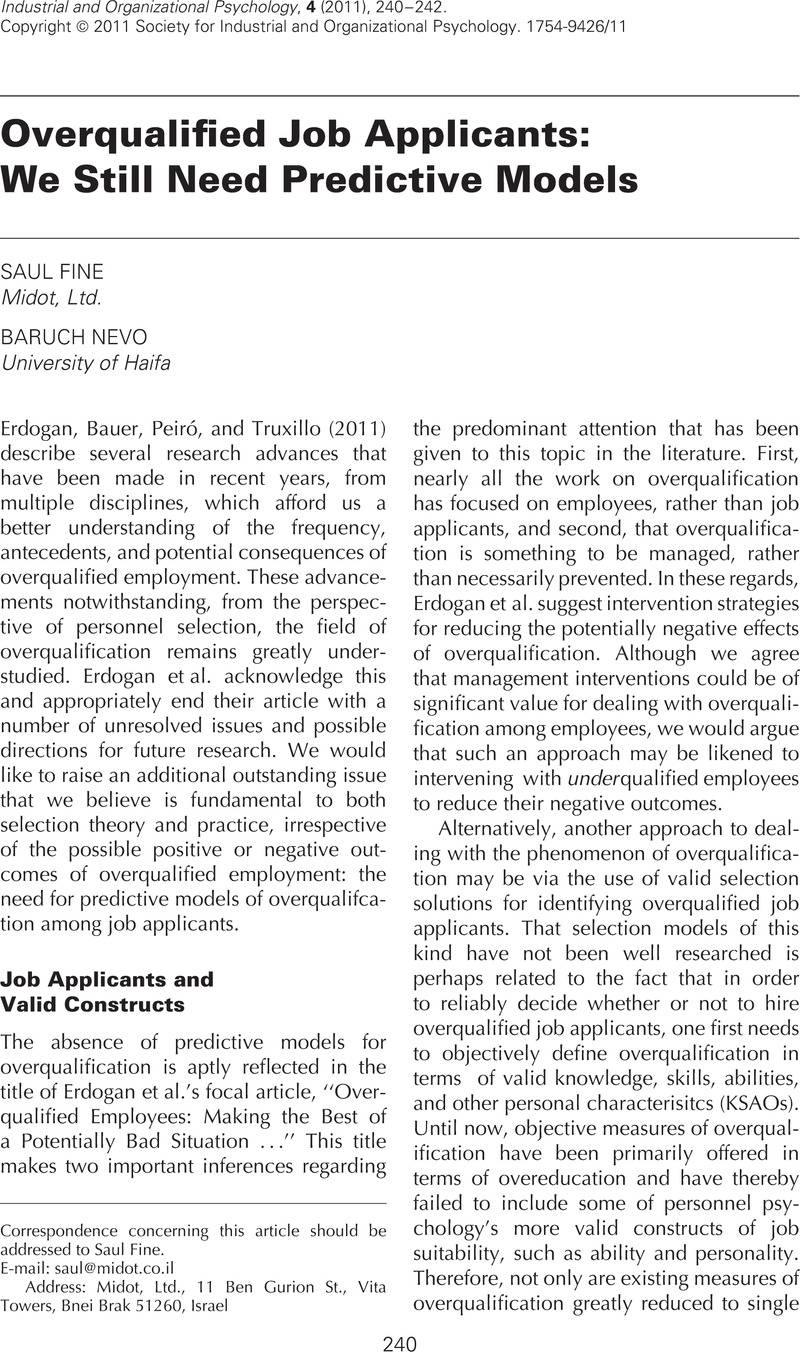Crossref Citations
This article has been cited by the following publications. This list is generated based on data provided by Crossref.
Erdogan, Berrin
Bauer, Talya N.
Peiró, José María
and
Truxillo, Donald M.
2011.
Overqualification Theory, Research, and Practice: Things That Matter.
Industrial and Organizational Psychology,
Vol. 4,
Issue. 2,
p.
260.
Liu, Songqi
and
Wang, Mo
2012.
The Role of the Economic Crisis on Occupational Stress and Well Being.
Vol. 10,
Issue. ,
p.
1.
Kulkarni, Mukta
Lengnick-Hall, Mark L.
and
Martinez, Patricia G.
2015.
Overqualification, mismatched qualification, and hiring decisions.
Personnel Review,
Vol. 44,
Issue. 4,
p.
529.
Guerrero, Laura
and
Hatala, John-Paul
2015.
Antecedents of perceived overqualification: a three-wave study.
Career Development International,
Vol. 20,
Issue. 4,
p.
409.
Lee, Gregory John
2015.
Training match and mismatch as a driver of key employee behaviours.
Human Resource Management Journal,
Vol. 25,
Issue. 4,
p.
478.
Wu, Chia-Huei
Luksyte, Aleksandra
and
Parker, Sharon K.
2015.
Overqualification and Subjective Well-Being at Work: The Moderating Role of Job Autonomy and Culture.
Social Indicators Research,
Vol. 121,
Issue. 3,
p.
917.
Thompson, Katina W.
Sikora, David M.
Perrewé, Pamela L.
and
Ferris, Gerald R.
2015.
Employment Qualifications, Person–Job Fit, Underemployment Attributions, and Hiring Recommendations: A three‐study investigation.
International Journal of Selection and Assessment,
Vol. 23,
Issue. 3,
p.
247.
Wu, ChiaaHuei
Wei Tian, Amy
and
Spitzmueller, Christiane
2016.
On the Association between Perceived Overqualification and Adaptive Behavior.
SSRN Electronic Journal,
Russell, Zachary A.
Ferris, Gerald R.
Thompson, Katina W.
and
Sikora, David M.
2016.
Overqualified human resources, career development experiences, and work outcomes: Leveraging an underutilized resource with political skill.
Human Resource Management Review,
Vol. 26,
Issue. 2,
p.
125.
Wu, Chia-Huei
Tian, Amy Wei
Luksyte, Aleksandra
and
Spitzmueller, Christiane
2017.
On the association between perceived overqualification and adaptive behavior.
Personnel Review,
Vol. 46,
Issue. 2,
p.
339.
Ma, Chao
Ganegoda, Deshani B.
Chen, (George) Zhen Xiong
Jiang, Xinhui
and
Dong, Chunyan
2020.
Effects of perceived overqualification on career distress and career planning: Mediating role of career identity and moderating role of leader humility.
Human Resource Management,
Vol. 59,
Issue. 6,
p.
521.
Moon, Hyejin
Chang, JaeYoon
and
Nam, SangHee
2021.
The effects of achievement attribution and career indecision on perceived overqualification.
Korean Journal of Industrial and Organizational Psychology,
Vol. 34,
Issue. 3,
p.
319.
KIR, Ayşe
and
AKÇAKANAT, Tahsin
2021.
Algılanan Aşırı Niteliklilik: Kavramsal Bir Değerlendirme.
Süleyman Demirel Üniversitesi Vizyoner Dergisi,
Vol. 12,
Issue. 31,
p.
1002.
Saad, Zuria Akmal
Fauri a.k.a. Fauzi, Muhammad Ashraf
Solat, Naliza
and
Salim, Azmi
2023.
Measuring Signal of Skill Mismatch from Online Job Advertisements and HR Roles: A conceptual paper.
Environment-Behaviour Proceedings Journal,
Vol. 8,
Issue. SI15,
p.
293.



